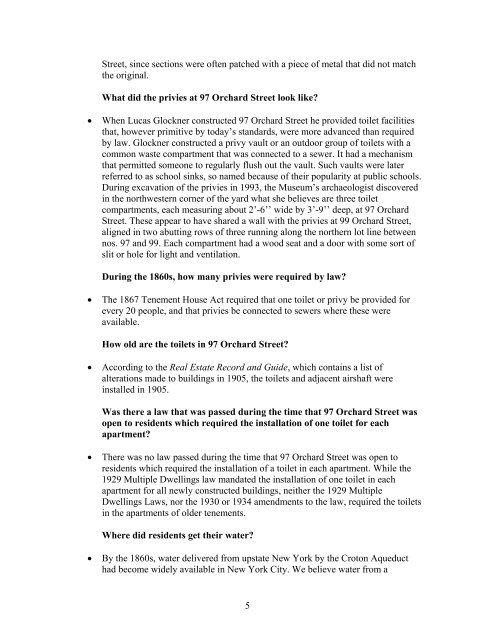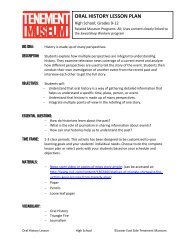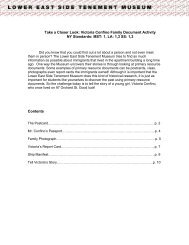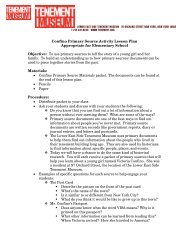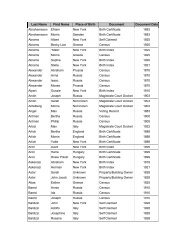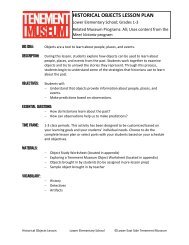97 Orchard Street FAQ - Lower East Side Tenement Museum
97 Orchard Street FAQ - Lower East Side Tenement Museum
97 Orchard Street FAQ - Lower East Side Tenement Museum
- No tags were found...
You also want an ePaper? Increase the reach of your titles
YUMPU automatically turns print PDFs into web optimized ePapers that Google loves.
<strong>Street</strong>, since sections were often patched with a piece of metal that did not matchthe original.What did the privies at <strong>97</strong> <strong>Orchard</strong> <strong>Street</strong> look like?• When Lucas Glockner constructed <strong>97</strong> <strong>Orchard</strong> <strong>Street</strong> he provided toilet facilitiesthat, however primitive by today’s standards, were more advanced than requiredby law. Glockner constructed a privy vault or an outdoor group of toilets with acommon waste compartment that was connected to a sewer. It had a mechanismthat permitted someone to regularly flush out the vault. Such vaults were laterreferred to as school sinks, so named because of their popularity at public schools.During excavation of the privies in 1993, the <strong>Museum</strong>’s archaeologist discoveredin the northwestern corner of the yard what she believes are three toiletcompartments, each measuring about 2’-6’’ wide by 3’-9’’ deep, at <strong>97</strong> <strong>Orchard</strong><strong>Street</strong>. These appear to have shared a wall with the privies at 99 <strong>Orchard</strong> <strong>Street</strong>,aligned in two abutting rows of three running along the northern lot line betweennos. <strong>97</strong> and 99. Each compartment had a wood seat and a door with some sort ofslit or hole for light and ventilation.During the 1860s, how many privies were required by law?• The 1867 <strong>Tenement</strong> House Act required that one toilet or privy be provided forevery 20 people, and that privies be connected to sewers where these wereavailable.How old are the toilets in <strong>97</strong> <strong>Orchard</strong> <strong>Street</strong>?• According to the Real Estate Record and Guide, which contains a list ofalterations made to buildings in 1905, the toilets and adjacent airshaft wereinstalled in 1905.Was there a law that was passed during the time that <strong>97</strong> <strong>Orchard</strong> <strong>Street</strong> wasopen to residents which required the installation of one toilet for eachapartment?• There was no law passed during the time that <strong>97</strong> <strong>Orchard</strong> <strong>Street</strong> was open toresidents which required the installation of a toilet in each apartment. While the1929 Multiple Dwellings law mandated the installation of one toilet in eachapartment for all newly constructed buildings, neither the 1929 MultipleDwellings Laws, nor the 1930 or 1934 amendments to the law, required the toiletsin the apartments of older tenements.Where did residents get their water?• By the 1860s, water delivered from upstate New York by the Croton Aqueducthad become widely available in New York City. We believe water from a5


